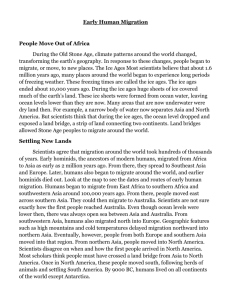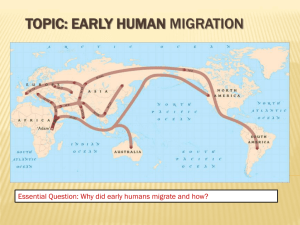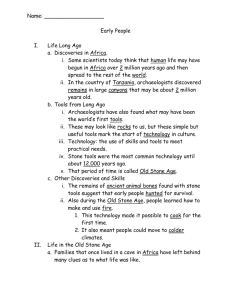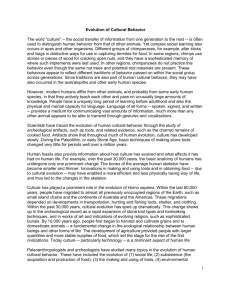The Ice Ages
advertisement
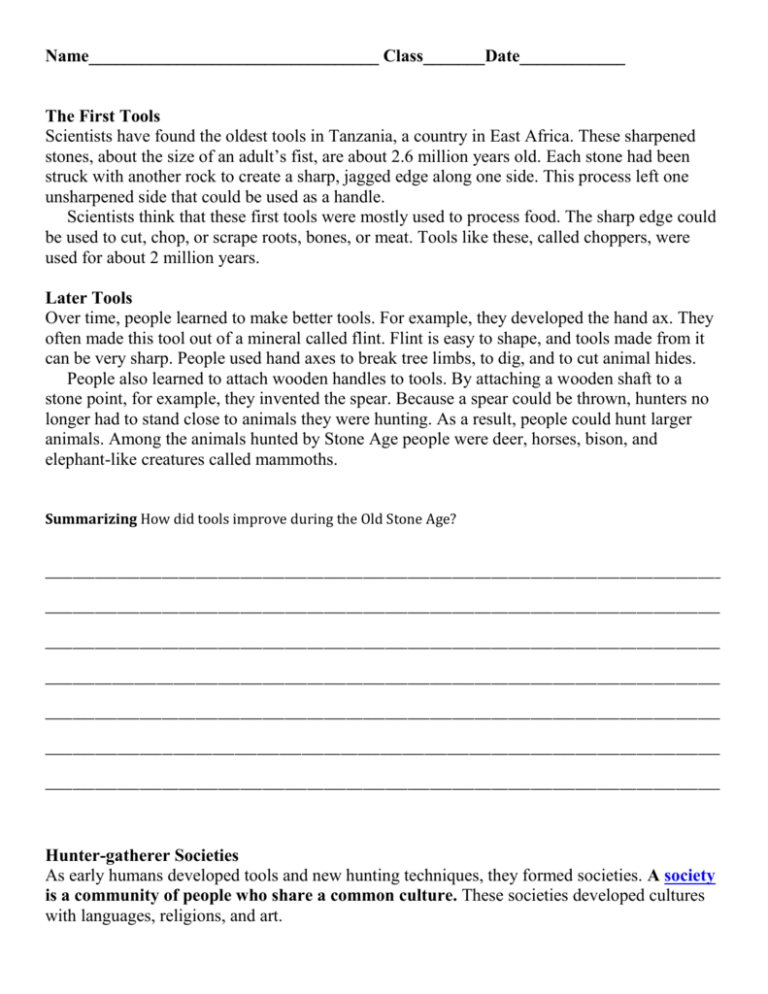
Name_________________________________ Class_______Date____________ The First Tools Scientists have found the oldest tools in Tanzania, a country in East Africa. These sharpened stones, about the size of an adult’s fist, are about 2.6 million years old. Each stone had been struck with another rock to create a sharp, jagged edge along one side. This process left one unsharpened side that could be used as a handle. Scientists think that these first tools were mostly used to process food. The sharp edge could be used to cut, chop, or scrape roots, bones, or meat. Tools like these, called choppers, were used for about 2 million years. Later Tools Over time, people learned to make better tools. For example, they developed the hand ax. They often made this tool out of a mineral called flint. Flint is easy to shape, and tools made from it can be very sharp. People used hand axes to break tree limbs, to dig, and to cut animal hides. People also learned to attach wooden handles to tools. By attaching a wooden shaft to a stone point, for example, they invented the spear. Because a spear could be thrown, hunters no longer had to stand close to animals they were hunting. As a result, people could hunt larger animals. Among the animals hunted by Stone Age people were deer, horses, bison, and elephant-like creatures called mammoths. Summarizing How did tools improve during the Old Stone Age? _________________________________________________________________________________________________________________________ _________________________________________________________________________________________________________________________ _________________________________________________________________________________________________________________________ _________________________________________________________________________________________________________________________ _________________________________________________________________________________________________________________________ _________________________________________________________________________________________________________________________ _________________________________________________________________________________________________________________________ Hunter-gatherer Societies As early humans developed tools and new hunting techniques, they formed societies. A society is a community of people who share a common culture. These societies developed cultures with languages, religions, and art. Society Anthropologists believe that early humans lived in small groups. In bad weather they might have taken shelter in a cave if there was one nearby. When food or water became hard to find, groups of people would have to move to new areas. The early humans of the Stone Age were hunter-gatherers—people who hunt animals and gather wild plants, seeds, fruits, and nuts to survive. Anthropologists believe that most Stone Age hunters were men. They hunted in groups, sometimes chasing entire herds of animals over cliffs. This method was both more productive and safer than hunting alone. Women in hunter-gatherer societies probably took responsibility for collecting plants to eat. They likely stayed near camps and took care of children. Language, Art, and Religion The most important development of early Stone Age culture was language. Scientists have many theories about why language first developed. Some think it was to make hunting in groups easier. Others think it developed as a way for people to form relationships. Still others think language made it easier for people to resolve issues like how to distribute food. Language wasn’t the only way early people expressed themselves. They also created art. People carved figures out of stone, ivory, and bone. They painted and carved images of people and animals on cave walls. Scientists still aren’t sure why people made art. Perhaps the cave paintings were used to teach people how to hunt, or maybe they had religious meanings. Describe two (2) ways tools were used during the Stone Age _________________________________________________________________________________________________________________________ _________________________________________________________________________________________________________________________ _________________________________________________________________________________________________________________________ _________________________________________________________________________________________________________________________ _________________________________________________________________________________________________________________________ People Move Out of Africa During the Old Stone Age, climate patterns around the world changed, transforming the earth’s geography. In response to these changes, people began to migrate, or move, to new places. The Ice Ages Most scientists believe that about 1.6 million years ago, many places around the world began to experience long periods of freezing weather. These freezing times are called the ice ages. The ice ages ended about 10,000 years ago. During the ice ages huge sheets of ice covered much of the earth’s land. These ice sheets were formed from ocean water, leaving ocean levels lower than they are now. Many areas that are now underwater were dry land then. For example, a narrow body of water now separates Asia and North America. But scientists think that during the ice ages, the ocean level dropped and exposed a land bridge, a strip of land connecting two continents. Land bridges allowed Stone Age peoples to migrate around the world. Settling New Lands Scientists agree that migration around the world took hundreds of thousands of years. Early hominids, the ancestors of modern humans, migrated from Africa to Asia as early as 2 million years ago. From there, they spread to Southeast Asia and Europe. Later, humans also began to migrate around the world, and earlier hominids died out. Look at the map to see the dates and routes of early human migration. Humans began to migrate from East Africa to southern Africa and southwestern Asia around 100,000 years ago. From there, people moved east across southern Asia. They could then migrate to Australia. Scientists are not sure exactly how the first people reached Australia. Even though ocean levels were lower then, there was always open sea between Asia and Australia. From southwestern Asia, humans also migrated north into Europe. Geographic features such as high mountains and cold temperatures delayed migration northward into northern Asia. Eventually, however, people from both Europe and southern Asia moved into that region. From northern Asia, people moved into North America. Scientists disagree on when and how the first people arrived in North America. Most scholars think people must have crossed a land bridge from Asia to North America. Once in North America, these people moved south, following herds of animals and settling South America. By 9000 BC, humans lived on all continents of the world except Antarctica. Analyzing How did the ice ages influence human migration? _________________________________________________________________________________________________________________________ _________________________________________________________________________________________________________________________ _________________________________________________________________________________________________________________________ _________________________________________________________________________________________________________________________ _________________________________________________________________________________________________________________________ _________________________________________________________________________________________________________________________ _________________________________________________________________________________________________________________________
